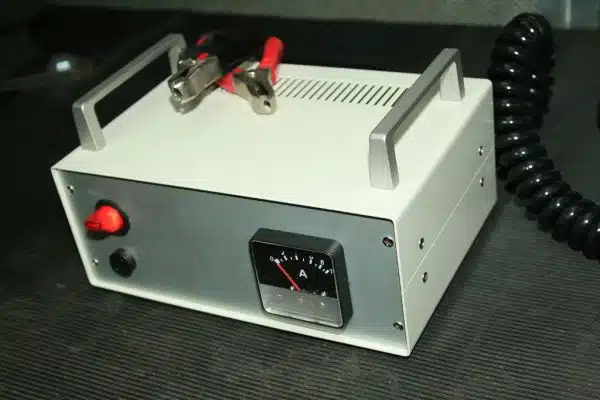As a safety expert and consultant, it is my responsibility to educate individuals on the proper ways to handle hazardous materials. One of the most common hazards encountered in households and workplaces is battery acid. Battery acid can be found in various types of batteries, including car batteries, household batteries, and rechargeable batteries. It is essential to know how to clean battery acid safely to prevent injuries or property damage.
Battery acid contains sulfuric acid, which is highly corrosive and can cause severe burns when it comes into contact with skin or eyes. Inhaling the fumes from battery acid may also result in respiratory problems. In this article, I will provide you with a comprehensive guide on how to clean battery acid safely and effectively. The information presented here will help you protect yourself and others while handling hazardous materials and ensure that your surroundings remain safe and secure.
Understanding Battery Acid And Its Dangers
Battery acid can be a dangerous substance if not handled properly. It’s important to understand its composition and potential sources of exposure. Battery acid is typically a solution of sulfuric acid and water, with a concentration ranging from 25% to 50%. Sulfuric acid is highly corrosive and can cause severe burns if it comes into contact with the skin or eyes. Ingestion of battery acid can also lead to internal chemical burns and other serious health problems.
Identifying potential sources of exposure is crucial for preventing accidents involving battery acid. This substance is commonly found in car batteries, but it can also be present in backup power supplies, cell phone batteries, and other electronic devices. When handling or transporting objects that contain battery acid, it’s important to take proper precautions to prevent spills or leaks. Accidents can happen unexpectedly, so it’s essential to always be aware of the risks associated with battery acid.
As a safety expert/consultant, I urge you to take battery acid seriously and prioritize safety when dealing with this substance. Understanding its composition and identifying potential sources of exposure are key steps in preventing accidents. By taking the time to educate yourself on these important topics, you’ll be better prepared to handle any situation involving battery acid safely and effectively. With this knowledge in mind, let’s move on to preparing for cleanup after an accident occurs.
Preparing For Cleanup
Understanding the dangers of battery acid is crucial in order to properly clean it up. Now that you have a basic understanding of what battery acid is and how dangerous it can be, it’s time to prepare for cleanup. Before proceeding with the actual cleanup process, there are several pre-cleanup steps that must be taken in order to ensure safety.
Pre-Cleanup Steps:
- Turn off all electronic devices and disconnect the battery – this will prevent any electricity from flowing through the battery.
- Put on personal protective equipment (PPE) – PPE includes gloves, goggles, and a respirator mask to prevent inhaling fumes.
- Ventilate the area – open windows or use fans to increase air circulation.
Safety precautions must always be taken when dealing with battery acid. It is highly corrosive and can cause severe burns and respiratory problems if not handled properly. Remember to never touch or ingest battery acid, avoid breathing in fumes, and keep it away from children and pets.
Gathering the necessary tools and materials for cleanup is essential in ensuring a safe and effective cleaning process. In order to clean battery acid safely, you will need baking soda, water, a plastic container for mixing solutions, a plastic scraper or brush, paper towels or rags for cleaning up spills, and a sealable plastic bag for disposal of contaminated materials. Gathering these materials before beginning cleanup will make the process smoother and safer.
Remember: safety always comes first when dealing with hazardous substances like battery acid. By taking proper precautions before beginning cleanup and gathering necessary tools and materials, you can effectively clean up battery acid without putting yourself or others at risk of harm.
Gathering The Necessary Tools And Materials
It is crucial to gather the necessary tools and materials before attempting to clean battery acid. The proper equipment helps ensure that the cleaning process is as efficient and safe as possible. As a safety expert, I highly recommend having a designated area for all your battery-related needs, such as charging and maintenance.
Storage options can include a toolbox or cabinet that is easily accessible yet out of reach of children or pets. Additionally, it would be best if you had recommended tools such as gloves, goggles, and masks to protect yourself from any potential harm. These tools are essential when cleaning battery acid since it can cause severe skin burns and respiratory issues.
Safety precautions should also be taken into consideration when dealing with battery acid. Always remember to keep batteries in a well-ventilated area away from any flammable liquids or gases. In case of an emergency, it is important to have an emergency response plan in place. Keep a fire extinguisher nearby and know how to use it properly.
Transitioning into the subsequent section about putting on protective gear, it is critical to emphasize that wearing personal protective equipment (PPE) is an essential step in preventing accidents when handling battery acid. Before proceeding with the cleaning process, make sure you have put on your PPE correctly. In the next section, we will discuss the different types of protective gear needed when working with battery acid and how to wear them properly for maximum effectiveness in ensuring your safety.
Putting On Protective Gear
After gathering the necessary tools and materials, it is crucial to put on appropriate protective gear before cleaning battery acid. Choosing suitable safety equipment is essential in ensuring that one does not suffer any harm while handling hazardous chemicals. Eye protection, chemical-resistant gloves, and a respirator are some of the standard safety gear required when dealing with battery acid.
It is vital to follow safety protocols when dealing with battery acid. Accidents can happen even with all the safety precautions in place, but following proper procedures minimizes the risk of injury or damage. Before starting, ensure that you have read and understood all the instructions for handling battery acid. Also, make sure that you are working in a well-ventilated area to avoid inhaling harmful fumes.
Choosing appropriate gear and following safety protocols are essential steps when cleaning battery acid safely. It is crucial to understand that corrosive substances like battery acid can cause severe burns or permanent damage if mishandled. Therefore, always prioritize your safety by putting on appropriate protective gear and following all instructions when dealing with hazardous chemicals like battery acid. In the next section, we will discuss how to ventilate the area before starting the cleaning process.
Ventilating The Area
Did you know that inhaling battery acid fumes can cause respiratory problems, such as coughing, shortness of breath, and chest pain? This is why ensuring proper ventilation during the cleanup process is essential. Proper ventilation helps to reduce the concentration of harmful fumes in the air and prevent health hazards.
Before starting the cleanup process, it is crucial to take safety precautions. Wear protective gear such as gloves, goggles, and a respirator mask to protect yourself from direct contact with the acid and its fumes. Additionally, make sure that the area where you will be cleaning up is well-ventilated. Open all windows and doors or use fans to increase airflow.
Remember that battery acid can be dangerous if not handled properly. Ensure proper ventilation by opening windows and doors or using fans before starting the cleanup process. Take safety precautions by wearing protective gear such as gloves, goggles, and a respirator mask. By doing so, you protect yourself from direct contact with battery acid and its fumes. The next section will discuss how to neutralize battery acid safely without causing further damage.
Neutralizing The Acid
Once you have identified and isolated the affected area, it is important to neutralize the acid before cleaning it up. Neutralizing the acid will help prevent further damage and make it safer to handle. There are several methods for neutralizing acids depending on the type of acid and surface involved. However, using a weak base such as baking soda or sodium bicarbonate is generally effective.
To neutralize battery acid safely, follow these steps:
- Wear protective gear: Before attempting to neutralize the acid, put on protective gear such as gloves, safety goggles, and a face mask to avoid contact with your skin, eyes, and respiratory system.
- Prepare the mixture: Mix one pound of baking soda with one gallon of water in a plastic or glass container. Stir until completely dissolved.
- Apply the mixture: Slowly pour or spray the solution onto the affected area until it stops fizzing. This indicates that all the acid has been neutralized. Use paper towels or rags to wipe away any residue.
Safe Disposal Methods
After neutralizing and cleaning up battery acid spills safely, you must dispose of any contaminated materials properly. Failing to do so can cause harm to people and animals around you as well as damage to the environment. Here are some safe disposal methods for battery acid:
- Never pour battery acid down a drain or into a landfill as it can contaminate groundwater.
- Place soaked rags and paper towels in an airtight plastic bag before disposing of them in your regular trash.
- Take damaged batteries to a recycling center that accepts hazardous waste.
By following these safe disposal methods, you not only protect yourself but also contribute positively towards environmental conservation efforts. Now that we have covered how to neutralize battery acid safely and dispose of any contaminated materials properly let’s move on to removing the battery from its compartment without causing further damage.
Removing The Battery
Identifying battery acid can be difficult, however it is typically an opaque yellow-greenish liquid with a pungent odor. When handling battery acid it is important to wear protective eyewear and gloves. To safely remove the battery, use caution when disconnecting the terminals and dispose of the battery according to local hazardous waste regulations. Finally, if any battery acid is spilled, neutralize the area with a mixture of baking soda and water.
Identifying Battery Acid
When it comes to cleaning battery acid, safety should be the top priority. Acid spills can be dangerous, and identifying battery acid is the first step in ensuring a safe cleanup process. Battery acid is a mixture of sulfuric acid and water, which gives off a strong acidic odor and has a yellow or brownish color. It can cause severe burns if it comes into contact with skin or eyes.
To safely clean up battery acid, it’s crucial to wear protective gear such as gloves, goggles, and an apron made of acid-resistant materials. Before removing the battery, test the pH levels of the acid using litmus paper or a digital pH meter. A pH level below 7 indicates acidic properties, while levels above 7 are alkaline. If the pH level is below 7, then the spill is likely to be battery acid.
When cleaning up battery acid spills, always use an appropriate neutralizer like baking soda or sodium bicarbonate to neutralize the acidic properties of the spill. Avoid using water as this will only spread the spill further. Rinse with water after neutralizing to ensure that all traces of acid have been removed. Proper identification of battery acid and following safety protocols can prevent accidents and injuries when handling hazardous substances such as batteries.
Removing The Battery
When it comes to removing a battery, safety should always be the top priority. Proper handling and precautions should be taken to avoid possible hazards that may occur during the process. Before removing the battery, it is important to ensure that all safety measures have been taken.
To remove a battery safely, start by turning off all power sources and disconnecting any electrical connections from the battery. Next, loosen the nuts or bolts that hold the battery in place using an appropriate tool. Carefully lift the battery out of its compartment without tipping it or spilling any acid.
During this process, it is essential to wear personal protective equipment such as gloves and goggles to prevent any exposure to acid or other hazardous materials. In addition, make sure to avoid placing any metal objects near the battery as this can cause a short circuit and lead to further hazards. Removing the battery safely requires careful attention and adherence to proper handling procedures.
Cleaning Up Spills And Contaminated Surfaces
Symbolism is an essential aspect of safety. The use of symbols can help people to recognize and understand potential hazards. When dealing with battery acid spills, it is crucial to be aware of the risks associated with the substance. Battery acid can cause severe burns and other injuries if not handled properly. As such, it is essential to take proper precautions when cleaning up spills.
Preventing contamination is a critical step in handling battery acid spills. To avoid spreading the acid to other areas, it is necessary to contain the spill as quickly as possible. This can be done by using absorbent materials such as sand or kitty litter. Once the spill has been contained, it is important to clean up any remaining traces of acid on surfaces or objects that may have come into contact with the substance.
Dealing with hard-to-reach spills requires additional care and attention. In some cases, it may be necessary to disassemble equipment or machinery to reach all affected areas. When doing so, it is important to wear protective gear such as gloves and goggles to prevent injury from exposure to the acid. Care should also be taken not to spread the acid further during cleanup.
Proper cleanup of battery acid spills requires careful attention and adherence to safety protocols. By taking appropriate precautions and following established procedures for containment and cleanup, you can minimize the risk of injury or contamination. In the next section, we will discuss safe methods for disposing of used batteries and related materials in order to reduce environmental impact and ensure safety for all involved parties.
Disposing Of The Acid And Related Materials
- Disposing of battery acid and related materials properly is essential for ensuring the safety of those handling the materials.
- Proper disposal requires knowledge of the local regulations and guidelines pertaining to hazardous materials.
- The acid and other materials should be stored in sealed containers and placed in a secure area away from potential sources of ignition.
- Properly disposing of materials such as batteries and containers must be done in accordance with applicable laws and regulations.
Safely Disposing Of The Battery Acid
Safely disposing of battery acid is crucial to prevent harm to the environment and individuals. Battery acid contains sulfuric acid, which is highly corrosive and can cause serious burns if it comes into contact with skin or eyes. Therefore, proper disposal methods must be followed to ensure safety.
One of the most common ways of disposing of battery acid is by neutralizing it with baking soda before pouring it down a drain. This method helps in reducing the acidity level and preventing damage to pipes or septic systems. However, it is essential to remember that this process should only be done in a well-ventilated area and while wearing protective gear such as gloves, goggles, and a mask.
Another option for safely disposing of battery acid is by contacting a hazardous waste disposal facility in your area. These facilities are equipped with specialized equipment and trained personnel who can handle battery acid and related materials safely. By opting for this method, you not only ensure that the environment is protected from potential harm but also contribute towards responsible waste management practices.
In conclusion, when it comes to disposing of battery acid safely, there are several options available that can reduce environmental impact while ensuring personal safety. Whether you choose to neutralize the acid yourself or contact a professional hazardous waste disposal service provider, the key takeaway is to never dispose of battery acid carelessly or recklessly. By following these simple steps, we can all do our part in protecting ourselves and our surroundings from harmful materials like battery acid.
Properly Disposing Of Related Materials
Properly disposing of related materials is just as important as safely disposing of battery acid. Negligence in the disposal of these materials can lead to serious harm to individuals and the environment. Therefore, it is essential to handle them with care and dispose of them responsibly.
One way to dispose of related materials is through recycling programs that are available in many areas. These programs accept various types of batteries, including lead-acid batteries commonly found in vehicles. Recycling helps reduce waste and minimize environmental impact while also complying with hazmat disposal regulations.
Another option for disposing of related materials is by contacting a professional hazardous waste disposal service provider. These providers have specialized equipment and trained personnel who can handle related materials safely and ensure proper disposal according to hazmat disposal regulations. By opting for this method, you not only contribute towards responsible waste management practices but also protect yourself and your surroundings from potential harm.
In conclusion, properly disposing of related materials is crucial for protecting individuals and the environment. Whether it’s through recycling programs or professional hazardous waste disposal services, it’s essential to follow hazmat disposal regulations to ensure safe handling and responsible disposal practices. By doing so, we can all play our part in serving others by minimizing environmental impact and promoting safety.
Treating Skin Or Eye Contact
If battery acid comes into contact with your skin or eyes, it is important to act quickly to prevent further damage. First aid for skin contact involves immediately flushing the affected area with plenty of water for at least 20 minutes. While doing so, remove any clothing or jewelry that may have been contaminated with the acid. For eye contact, hold the eyelids open and flush the eye with water for at least 20 minutes as well. Seek immediate medical attention for any skin or eye contact with battery acid.
In case of emergency situations involving battery acid exposure, it is important to call for emergency response services right away. These situations include when a large amount of battery acid has spilled or if a person has ingested the acid accidentally. Emergency responders are equipped to handle these situations and can provide professional assistance in decontaminating the affected area.
It is crucial to remember that quick action can make all the difference in preventing further damage from battery acid exposure. By following proper first aid procedures and calling for emergency response services when necessary, you can protect yourself and those around you from potentially harmful effects of battery acid exposure. Seeking medical attention after initial treatment is also advised to ensure complete recovery from any injuries sustained from exposure.
Seeking Medical Attention
It cannot be emphasized enough how crucial it is to seek medical attention immediately after exposure to battery acid. Delaying medical intervention may lead to severe complications that can be life-threatening. It is necessary to understand the importance of seeking prompt medical care and the risks involved in delaying it.
The risks of delaying medical attention after battery acid exposure can be fatal. The acidic substance can cause skin burns, respiratory problems, and eye damage if left untreated. Inhaling the fumes from battery acid can also cause severe lung damage and breathing difficulties. Therefore, it is essential to seek immediate medical attention if you have been exposed to battery acid.
If you have been exposed to battery acid, seeking medical attention should be your top priority. Once you arrive at the hospital or clinic, the healthcare professionals will assess your condition and provide appropriate treatment. Treatment may involve cleaning the affected area thoroughly, providing pain relief medication, administering antibiotics if required, and monitoring for any complications that may arise. Remember that seeking immediate medical attention can save your life.
Moving on from seeking prompt medical care, prevention tips for future incidents are equally important.
Prevention Tips For Future Incidents
To prevent future incidents involving battery acid, it is important to educate oneself on the proper handling techniques for batteries. Many individuals are unaware of the potential dangers associated with batteries and their acids, leading to accidental spills or leaks that can cause harm to people and property. By becoming informed about how to handle batteries safely, individuals can greatly reduce the risk of such incidents occurring.
One important aspect of handling batteries safely is ensuring that they are stored in a secure location when not in use. Batteries should be kept in a cool, dry place away from direct sunlight and sources of heat. Additionally, they should be stored upright and away from other materials that may react with them, such as metal or water. Proper storage not only reduces the risk of acid leaks but also prolongs the life of the battery itself.
In addition to proper storage techniques, it is also important to handle batteries with care during use. This includes wearing appropriate protective gear such as gloves and safety glasses when working with batteries, as well as avoiding overcharging or puncturing them. By taking these precautions and staying informed about safe battery handling practices, individuals can help prevent future incidents involving battery acid.
Moving forward, it is crucial to understand the importance of education and proper handling techniques when it comes to preventing accidents involving battery acid. By taking proactive measures such as proper storage and careful use, individuals can greatly reduce their risk of harm while also protecting their property and equipment from damage. In the next section, we will discuss further steps you can take towards ensuring your safety when dealing with batteries – namely, proper storage techniques that will help keep your battery secure at all times.
Proper Storage Of Batteries
It is essential to store batteries properly to avoid any mishaps that may lead to damage or leakage. When storing batteries, the first step is to separate them by type and size. This separation ensures that there are no mix-ups between different types of batteries, which could result in short-circuiting or even explosions.
Proper battery disposal is also crucial in maintaining safety during storage. It is recommended that old or used batteries be disposed of correctly, as they can still pose a risk even if not in use. Batteries should be taken to designated recycling centers where they can be disposed of safely and appropriately.
Battery storage safety precautions must also be observed at all times. When storing batteries, ensure they are stored at room temperature and kept away from heat sources such as direct sunlight or radiators. Additionally, keep batteries out of reach of children and pets who might accidentally swallow them, leading to severe harm.
To avoid any accidents when handling batteries, it’s essential to identify signs of damage or leakage before storage. The next section will discuss how to identify these warning signs and what measures can be taken to handle such situations safely.
Identifying Signs Of Damage Or Leakage
As a safety expert, it is crucial to be aware of the signs of battery acid damage and leakage. Battery acid damage can occur due to a variety of reasons, including overcharging, exposure to extreme temperatures, and physical damage. It is important to know that even small amounts of battery acid leakage can lead to significant harm if left unaddressed.
One of the key indicators of battery acid damage is corrosion. Corrosion can manifest as a white or blue-green powdery substance on the surface of the battery or surrounding areas. You may also notice the presence of cracks or leaks in the battery casing. If you detect any of these signs, it is essential to take immediate action.
Preventing battery acid leakage is crucial for maintaining safety at all times. One way to prevent leakage is by ensuring that batteries are stored in an appropriate location and environment. Avoid exposing batteries to extreme temperatures or moisture as this can cause them to leak. Additionally, do not attempt to modify or tamper with batteries as this can also lead to leakage.
It’s critical to identify any signs of battery acid damage early on and take necessary precautions immediately. Seeking professional help when necessary is an important step towards ensuring your safety and preventing further harm from occurring. In the next section, we will discuss what steps you should take if you suspect battery acid damage or leakage and how seeking professional assistance can help you avoid further complications.
Seeking Professional Help When Necessary
Ensuring safety when cleaning battery acid is of utmost importance. Battery acid contains sulfuric acid, which is highly corrosive and can cause severe burns and damage to the skin, eyes, and respiratory system. Therefore, it is essential to take all necessary precautions while dealing with battery acid.
While it may be tempting to clean the battery acid yourself, seeking professional help is highly recommended. Professional cleanup services have the expertise, equipment, and experience needed to deal with battery acid safely and efficiently. The cost of professional cleanup services may seem expensive at first glance, but it is a small price to pay for your safety and peace of mind.
Additionally, attempting to clean battery acid without proper training or equipment can lead to further damage or contamination. It could also result in improper disposal of hazardous materials, which can harm the environment. Therefore, if you are not confident in your ability to handle battery acid safely or do not have access to proper protective gear and equipment, seek professional help immediately. Remember that the cost of professional cleanup services is minimal compared to the potential risks involved in handling battery acid improperly.
Conclusion
Battery acid is a highly corrosive substance that can cause serious injury or damage if not handled properly. It is important to take all necessary precautions when cleaning up battery acid, including wearing protective gear and ensuring proper ventilation.
Before beginning the cleanup process, it is important to gather all necessary tools and materials, such as gloves, goggles, baking soda, and a neutralizing agent. Once you have put on your protective gear and ventilated the area, you can begin cleaning up the battery acid.
To prevent future incidents, it is essential to store batteries in a safe and secure location away from children and pets. Additionally, regularly inspect your batteries for signs of damage or leakage and seek professional help if necessary.
In conclusion, cleaning battery acid safely requires careful preparation, protective gear, ventilation, and proper storage of batteries. As a safety expert/consultant, I would like to remind you that handling battery acid requires caution and attention to detail. Remember that just as a small spark can ignite a wildfire, even a small mistake when dealing with battery acid can have serious consequences. So always be vigilant and follow safety protocols to avoid any potential risks.
Image Credits
- “diy sealed lead acid battery charger” by h080 (featured)





























